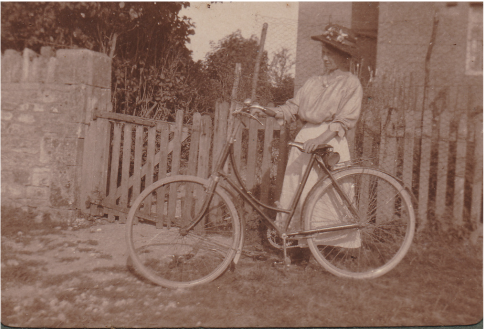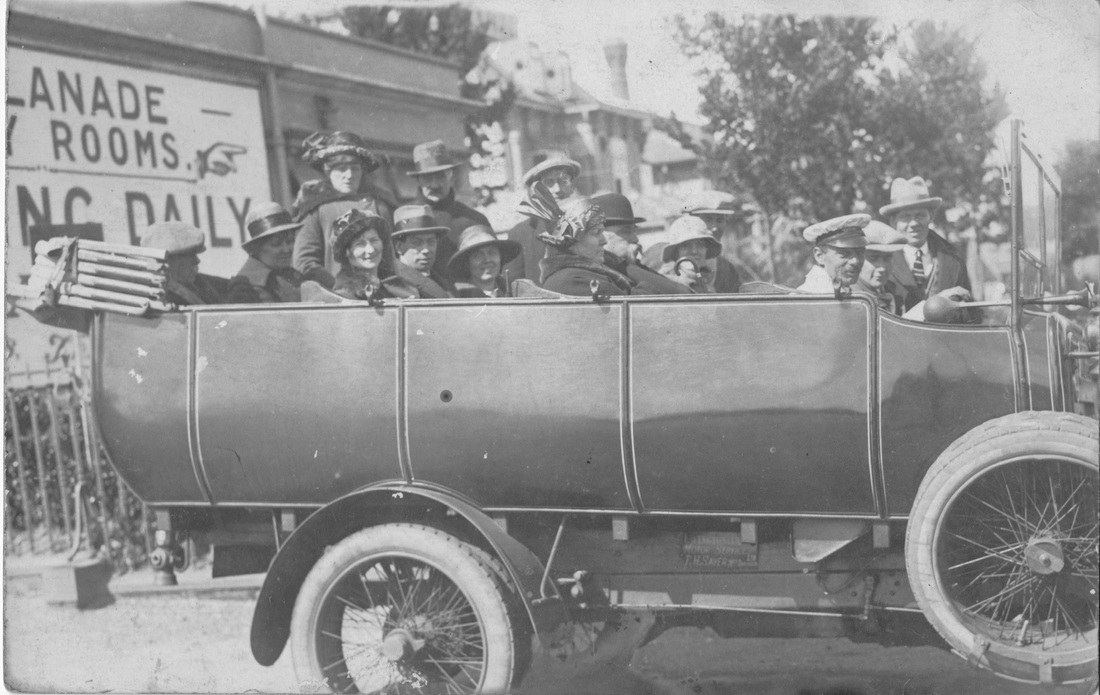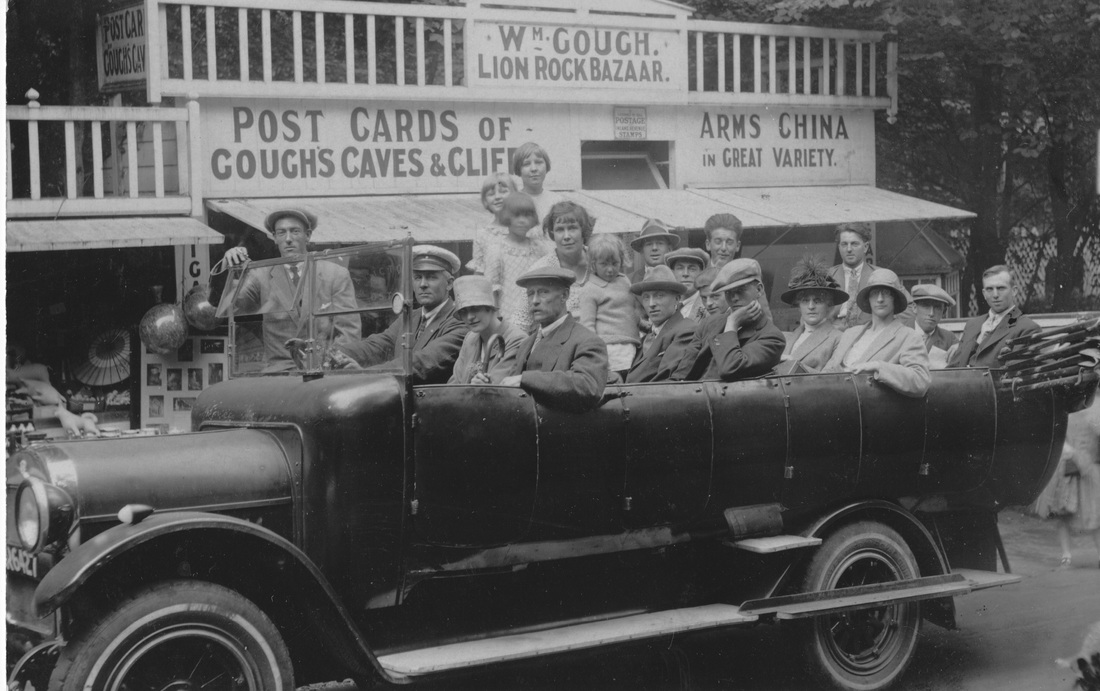After the Railways
This is the story of the growth of outings from Box for ordinary people: by car, omnibus and bicycle. As prosperity grew in late Victorian times, so travel opportunities arose which previously had been limited to the middle and upper classes.
Transport altered as much in the late Victorian period as it did in the 1850s and 1860s when horse and canal gave way to great steam-driven railroads which criss-crossed the whole country. But even cheap rail transport was outside the everyday resources of most people in Box, who still walked for most purposes: to work, social events and to the village shops.
Early travel opportunities were organised as a regular community occurrence by village organisations and clubs. The Sunday Schools and local friendly societies arranged outings to coincide with the Bank Holidays of Boxing Day, Easter Monday, Whit Monday and the first Monday in August, all of which were made official non-working days in 1871.[1]
This is the story of the growth of outings from Box for ordinary people: by car, omnibus and bicycle. As prosperity grew in late Victorian times, so travel opportunities arose which previously had been limited to the middle and upper classes.
Transport altered as much in the late Victorian period as it did in the 1850s and 1860s when horse and canal gave way to great steam-driven railroads which criss-crossed the whole country. But even cheap rail transport was outside the everyday resources of most people in Box, who still walked for most purposes: to work, social events and to the village shops.
Early travel opportunities were organised as a regular community occurrence by village organisations and clubs. The Sunday Schools and local friendly societies arranged outings to coincide with the Bank Holidays of Boxing Day, Easter Monday, Whit Monday and the first Monday in August, all of which were made official non-working days in 1871.[1]
Getting Away
In the summer of 1897, Box choirboys travelled in James Browning’s horse-drawn brake to Bristol, a three-hour journey.[2] They went by steamer up the Avon to Clifton and visited the Suspension Bridge, the Cathedral and the zoo, returning by horse-drawn tram. The trip was judged a great success, marred just a little by leaving four boys behind in the zoo!
They were great social events. The three penny trip to the briny for the Church of England Temperance Society in 1902 went by train to Weston-Super-Mare.[3] Groups of Box residents organised themselves to go on outings, often to places they had heard of but never previously seen like Cheddar and Weston- super-Mare.
In the summer of 1897, Box choirboys travelled in James Browning’s horse-drawn brake to Bristol, a three-hour journey.[2] They went by steamer up the Avon to Clifton and visited the Suspension Bridge, the Cathedral and the zoo, returning by horse-drawn tram. The trip was judged a great success, marred just a little by leaving four boys behind in the zoo!
They were great social events. The three penny trip to the briny for the Church of England Temperance Society in 1902 went by train to Weston-Super-Mare.[3] Groups of Box residents organised themselves to go on outings, often to places they had heard of but never previously seen like Cheddar and Weston- super-Mare.
A New Age
People recognised that the outings were a wondrous new experience and celebrated them as great popular events. A Sunday School outing by train included some children from Wadswick, who arrived by Mr Rowe’s wagon which presented a gay appearance, being decorated with flowers.
Even simple trips were almost magical events. In 1902 the Sunday School went to Hartham Park where the Misses Northey were a source of great entertainment and interest by playing their gramophone. The children played games and were awarded prizes including the New Testament containing a facsimile of the autograph of the late Queen.[4]
Cycling Craze
People recognised that the outings were a wondrous new experience and celebrated them as great popular events. A Sunday School outing by train included some children from Wadswick, who arrived by Mr Rowe’s wagon which presented a gay appearance, being decorated with flowers.
Even simple trips were almost magical events. In 1902 the Sunday School went to Hartham Park where the Misses Northey were a source of great entertainment and interest by playing their gramophone. The children played games and were awarded prizes including the New Testament containing a facsimile of the autograph of the late Queen.[4]
Cycling Craze
 Mary Wikins probably in 1900s (photo courtesy Stella Clarke)
Mary Wikins probably in 1900s (photo courtesy Stella Clarke)
After about 1870 bicycles were being built by the local village blacksmith but it was the invention of the pneumatic tyre in 1888 by John Boyd Dunlop that started the great cycling craze. It was a craze that united classes, ages and sexes throughout the country.[5]
It was a desire for speed, bonding together in clubs and a chance to talk privately to the opposite sex without parental supervision.
It didn't please all. Cyclists alarmed pedestrians and animals on the road, raising clouds of dust and moving at unexpected speeds up to 12 miles per hour.[6] The government acted by making bells and lights compulsory in 1888.
It was a desire for speed, bonding together in clubs and a chance to talk privately to the opposite sex without parental supervision.
It didn't please all. Cyclists alarmed pedestrians and animals on the road, raising clouds of dust and moving at unexpected speeds up to 12 miles per hour.[6] The government acted by making bells and lights compulsory in 1888.
Cycling caused a heated argument between the Parish Council and Rev Sedgwick of Alcombe House about the state of the roads. He complained that, in the hamlet, the poor condition of the road surface had necessitated his buying a new cycle tyre and saddle spring. The road was a danger to my nurse and pram.[7] By 1900 the Parish Council were expressing concern about dangerous road racing by cyclists in the village in summer and autumn.[8]
Dangers and Mishaps
It was the spirit of adventure that raised the unusualness of the outings and many ended in unforeseen consequences. In September 1903 there was a train visit to Bournemouth, returning from Bath Station to Box at 10.30pm by a Bath roadcar. Unfortunately the driver had great difficulty in finding his way without streetlights and the party elected to dismount (at Shockerwick) and walk the remainder of the journey, feeling safer in so doing. What a difference to today's pedestrian experience!
In 1912 Mrs Browning and Mrs Goulstone organised a visit of forty members of the Mothers' Union to Cheddar by motorbus, which broke down on the way! Now that might even happen to us!!
Dangers and Mishaps
It was the spirit of adventure that raised the unusualness of the outings and many ended in unforeseen consequences. In September 1903 there was a train visit to Bournemouth, returning from Bath Station to Box at 10.30pm by a Bath roadcar. Unfortunately the driver had great difficulty in finding his way without streetlights and the party elected to dismount (at Shockerwick) and walk the remainder of the journey, feeling safer in so doing. What a difference to today's pedestrian experience!
In 1912 Mrs Browning and Mrs Goulstone organised a visit of forty members of the Mothers' Union to Cheddar by motorbus, which broke down on the way! Now that might even happen to us!!
[1] Christopher Hibbert, The English: A Social History, 1987, Paladin, p.683
[2] Parish Magazine, 1897
[3] Parish Magazine, 1903
[4] Parish Magazine, 1902
[5] Christopher Hibbert, The English: A Social History, 1987, Paladin, p.659
[6] Paul Hindle, Roads and Tracks for Historians, 2001, Phillimore & Co Ltd, p.128
[7] Clare Higgens, Box Wiltshire: An Intimate History, 1985, Downland Press, p.50
[8] Clare Higgens, Box Wiltshire: An Intimate History, p.49
[2] Parish Magazine, 1897
[3] Parish Magazine, 1903
[4] Parish Magazine, 1902
[5] Christopher Hibbert, The English: A Social History, 1987, Paladin, p.659
[6] Paul Hindle, Roads and Tracks for Historians, 2001, Phillimore & Co Ltd, p.128
[7] Clare Higgens, Box Wiltshire: An Intimate History, 1985, Downland Press, p.50
[8] Clare Higgens, Box Wiltshire: An Intimate History, p.49

